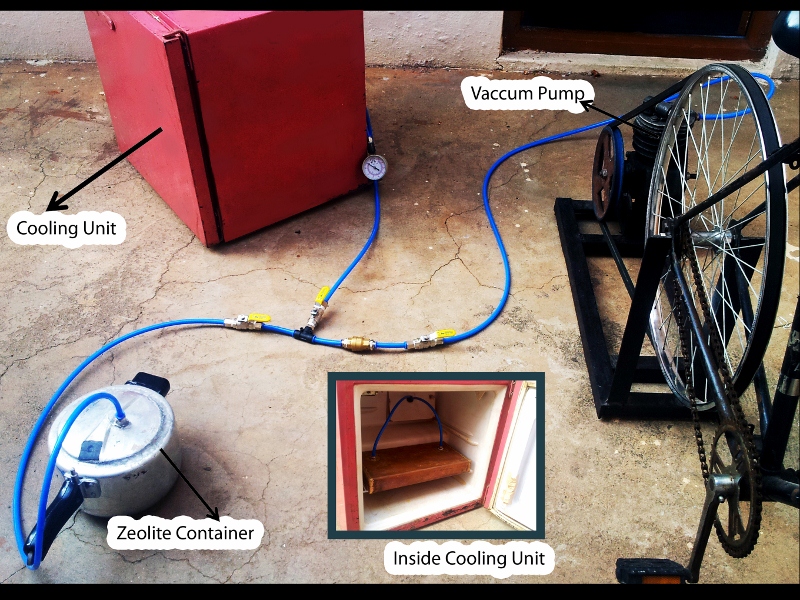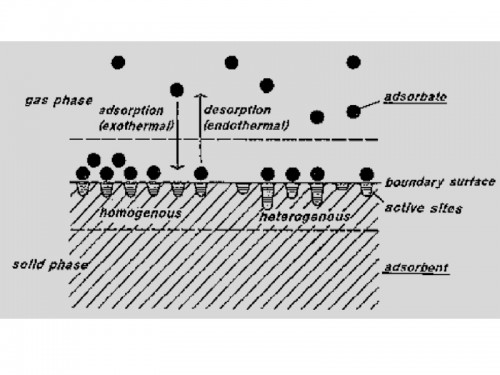TBI Innovations: The Mechanical Fridge – Freezing Environmental Damage
Narendra Patil, a third year engineering student from Karnataka and his fellow mates tapped the positive side of technology and their engineering knowledge, to come up with a unique model of an eco-friendly refrigerator. It not only runs without electricity but can also be available to the poor as an inexpensive and necessary utility option. Read about the wonderful innovation here.

Narendra Patil, a third year engineering student from Karnataka and his fellow mates tapped the positive side of technology and their engineering knowledge, to come up with a unique model of an eco-friendly refrigerator. It not only runs without electricity but can also be available to the poor as an inexpensive and necessary utility option and no longer as a luxury one meant only for those with large pockets. Hence, with one shot, the special refrigerator addresses the dual issues of ‘economic availability to the poor’ and ‘sustainable ecological development’.
Technology is indeed like a two-sided coin. While we can go gung-ho about technological progress and how it has simplified our lives, we can also talk about in the same breath about the adverse effects of technology, particularly on the environment. Take the refrigerator, for example. It is a remarkable technological offering that has made our lives a lot cooler. We are able to keep food fresh, preserve fruits, vegetables and dishes for longer, relish cold food items in blistering temperatures and most importantly make the good ol’ ice. But the refrigerator too has two sides to it. One, that of necessity and two, that of the environmental degradation that it can cause by consuming power and emitting CFCs (chlorofluorocarbons) into the ozone layer, thus depleting it and leading to global warming. Clearly, what is required is a neutral zone wherein a refrigerator is available to all, yet with minimal adverse environmental impact.

This was what motivated the third year Engineering student from BEC College, Bagalkot, Karnataka, Narendra Patil to come up with this interesting model of a refrigerator. The idea started off as their topic for the final year project. Obviously, it was not just the marks that the design could fetch, it was also the delightful revolution that this could bring about, something that Narendra and his fellow batch mates, Anil and Murthy were very proud about – of making the refrigerator an affordable and economical choice and not just a luxurious one among even the lower income population. The reason behind its cost efficiency is its zero power consumption and no requirement of fossil fuels to burn the planet in the process of cooling. Narendra recalls:
We live in the North geographical region of Karnataka, where temperature is usually high in summer (35-39 degrees celsius). Back in college we used to have our practicals in workshops, where we used to get exhausted by the time we finished. After finishing the practicals, I used to go to a cold drink shop and have soda even though I knew it was not good for health, but I didn’t have an option because I didn’t have a fridge in my room. Then a thought struck me that what would be the state of those poor who didn’t even have money to buy a cold drink. Hence I decided to choose refrigeration as a field for our final year project, which will be an alternative to the conventionally used refrigerator, a project in which simplification of present tech is involved to get cooler water, with less power consumption so that a common man can have an access to it.
Interestingly, another technological accomplishment in the arena of social networking, YouTube, helped the trio in their cause. Narendra was inspired by the YouTube video, which was “Pedal powered Refrigerator using Zeolite-Water pair” and shared this with Anil and Murthy and thus began their journey to make their dreams a reality. They collected research papers and supporting documents in the seventh semester.
The working principle and the mechanism of the refrigerator is explained below in the budding engineer’s own words and supported by a diagram.
Working Principle
- Initially vacuum is created in adsorbent (zeolite) unit using vacuum pump.
- Valve connecting vacuum pump & evaporator chamber is opened and that of adsorbent container is kept closed.
- Vacuum is generated in the evaporator chamber containing adsorbate (methanol), with help of vacuum generating system.
- This reduces the partial pressure of methanol, as a result phase transformation takes place from liquid to vapour state
- Heat utilised in the phase transformation is extracted from the evaporated chamber.
- Now the compressor valve is closed and that of zeolite evaporator is opened, this makes the passage for zeolite to adsorb the vaporised particles over its surface area, viz. Physical adsorption phenomena.
- On completion of above five steps a slight depression of temperature is observed over the surface evaporator chamber.
- By repeating the whole cycle for number of times we can obtain considerable cooling effect in the cooling unit.
The refrigerator would work on the principle of adsorption. Adsorption occurs at the surface interface of two phases, in which cohesive forces including electrostatic forces and hydrogen bonding act between the molecules of all substances irrespective of their state of aggregation, causing changes in the concentration of molecules at the solid/fluid interface. Thus, adsorption is the adhesion of atoms, ions or molecules from a gas, liquid or dissolved solid to a surface. The adsorbing phase is the adsorbent, and the material concentrated or adsorbed at the surface of that phase is the adsorbate. In the designed refrigerator, zeolite is the adsorbent and methanol can be treated as refrigerant. This process creates a film of the adsorbate (methanol) on the surface of the adsorbant (zeolite).

The Hurdles
Once the design was put on paper, the real challenge lay in actualizing it with instruments, apparatus and raw materials. But here lay the glitch. The major items required were not available in their district. Even with exams nearing and project deadlines looming large over their heads, they travelled from store to store and went that extra mile.
The procurement started with getting the hero of the project, ie zeolite itself. Says Narendra:
Somehow we got the Zeolite retail seller address from Bengaluru, because most of the sellers we contacted were whole sellers who did their business in tons but our requirement was in few kgs only. But it was not the specification we intended, the seller said “that’s what he has and also the same is used in local Industries.
Some of their efforts were wasted too as the few apparatus they had bought earlier were hydraulic valves and not pneumatic valves. There were other challenges too and corresponding modifications done. Narendra explains:
Initially we built the Evaporator unit of GI-sheet, without internal support. While experimenting, it couldn’t sustain the vacuum we generated within it, as a result it compressed. Later we chose copper sheet with internal support. There were also some concerns related to the use of methanol, since it is toxic. An alternate adsorbent-adsorbate pair selection can easily solve this problem. Yet, we chose methanol replacing water because of failure in attainment of desired vacuum point to start the phase transformation which leads to adsorption phenomena.
Advantages and USPs
Apart from the refrigerator being inexpensive and not requiring any fossil fuels/power for its running, the refrigerator model presents the added advantage of not needing frequent maintenance, repairing or changing the system, since the life duration of their chosen adsorbent, zeolite is eternal and the entire working process is completely natural instead of mechanical. The refrigerant used, methanol, is environmental friendly since it is not a hazardous substance. Besides, the potentially portable and ‘hand run’ device can even be employed as a thermal energy storage device.
With further modification and up gradation, Narendra hopes that the refrigerator could be used in remote areas with lesser access to power. There are also many other essential purposes that such refrigerators could be utilized for apart from storing food, as Narendra points out. It could be used in medical camps (again in rural areas) for preserving vaccines and drugs and as water cooling units.

Limitations
While confident about the pros of his refrigerator model, Narendra and his team simultaneously hope to address the cons of the model as well, to achieve the best possible efficiency. The limitations that they are working on include the low COP values, poor heat and mass transfer problem that poses a bottleneck to prevent the improvements of adsorption refrigeration technique, intermittently working principles, high technology requirement and special designs to maintain high vacuum.
Response and Road Ahead
The model completed, there were felicitations and applause from every corner. Narendra tells us proudly:
Our Project Guide was happy to see the results and appreciated our hard work. When we posted about the project on FACEBOOK we got very good response from our friends and relatives too.
Amidst all the happy stuff, their only regret is that they didn’t file their project idea for state level sponsorship programme, thus, missing out on the opportunity to showcase their project at the state level exhibition and get funding.
That said, they are their own critics and perfectionists. They have more plans up their sleeves for further modification, research and up gradation as they believe that the refrigerator can be made more sustainable and efficient than what it presently is, realizing their ultimate goal to serve the poor man’s demand in remote areas to preserve vaccine and food as one third of the Indian population doesn’t have access to power.
As Narendra says:
There is research going on the solar powered adsorption refrigeration. We did this prototype model with our UG capabilities and available sources within our reach and we can assure you that with more dedication , research and better design we can build a sustainable model.
We wish you all the best in this meaningful endeavour!
Click here to access the Project Report, and view their video here.
If you found our stories insightful, informative, or even just enjoyable, we invite you to consider making a voluntary payment to support the work we do at The Better India. Your contribution helps us continue producing quality content that educates, inspires, and drives positive change.
Choose one of the payment options below for your contribution-
By paying for the stories you value, you directly contribute to sustaining our efforts focused on making a difference in the world. Together, let's ensure that impactful stories continue to be told and shared, enriching lives and communities alike.
Thank you for your support. Here are some frequently asked questions you might find helpful to know why you are contributing?


This story made me
-
97
-
121
-
89
-
167














